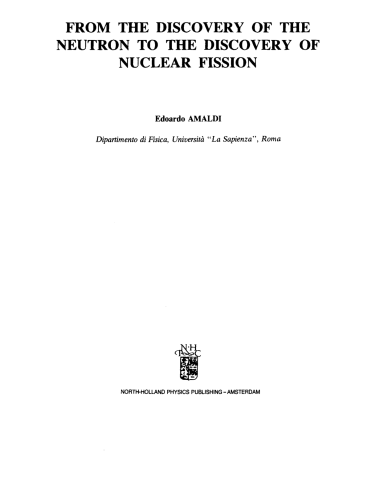From the Discovery of the Neutron to the Discovery of Nuclear Fission

The widespread and deep interest for the history of Modern Physics which one finds among physicists has prompted Physics Reports to try to offer to its readers a few articles which would cover the history of major developments in our field. We are extremely fortunate to have as the first article of this type a brilliant survey of a great era in Nuclear Physics, “From the discovery of the neutron to the discovery of nuclear fission”, by Professor E. Amaldi. It takes the reader through fascinating years of rapid developments in our understanding of nuclear structure.
The situation by the middle of 1957 was rather confused [357].One could explain the backward electron asymmetry by muon decay with either helicity of the neutrino and the experiments on nuclear beta decay could be explained by means of a ST combination if H(νe) = +1 or, equally well, by a VA combination if H(νe) = 1.
Two electron—neutrino correlation experiments favored contradictory interpretations. The first one, carried out with [He6 to Li6 transition], favored the ST possibility, while another experiment with A35 tended to favour the VA combination. While V and A respect helicity conservation, S ,P and T flip the helicity.
Furthermore, early determinations (1955—1957) of the branching ratio [equation] gave upper limits of the order of 10~to 10_6, which were inconsistent with estimates based on the VA combination [378].
In the summer of 1957 Marshak and Sudarshan [379] proposed a new principle, called “chirality invariance” which led to a very specific combination of V and Afour-fermion interaction, namely the V—A combination.
They argued that the “universal weak interaction” while not preserving parity preserves “chirality” and the maximum violation of parity is brought about by the requirement of chirality invariance [380].
They gave also a sound footing to this conclusion by a detailed analysis of the results of the majority of the experiments then available. A few other experiments had to be wrong, as it was directly shown shortly after [381].
The same conclusion was deduced by Feynmann and Gell-Mann following a different line of thought [382], and some time later by Sakurai [383]who invoked a different principle shown, still later, to be equivalent to chirality invariance.
I should also recall that Bruno Touschek, already a few months before all these authors, had shown that the conservation of leptonic number in presence of parity non-conservation is compatible only with the V—A theory [384].His derivation is less general and based on a rather limited set of experiments, examined less profoundly than in the papers by Feynmann and Gell-Mann and by Marshak and Sudarshan. The conclusion, however, is clearly there.